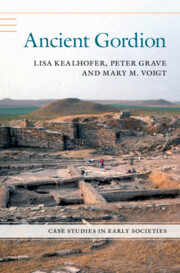Book contents
- Ancient Gordion
- Case Studies in Early Societies
- Ancient Gordion
- Copyright page
- Contents
- Acknowledgments
- Abbreviations
- 1 Introduction
- 2 Inventing Identity
- 3 Contextualizing the Ceramic Assemblage
- 4 Identifying Gordion’s Groups
- 5 The Late Bronze Age Community at Gordion
- 6 Reconstituting Community in the Early Iron Age
- 7 New Identities, New Communities
- 8 Enacting Power
- 9 Identities in Flux
- 10 Conclusion
- Appendix Eski Çağ’da Gordion:
- References
- Index
4 - Identifying Gordion’s Groups
Published online by Cambridge University Press: 23 September 2022
- Ancient Gordion
- Case Studies in Early Societies
- Ancient Gordion
- Copyright page
- Contents
- Acknowledgments
- Abbreviations
- 1 Introduction
- 2 Inventing Identity
- 3 Contextualizing the Ceramic Assemblage
- 4 Identifying Gordion’s Groups
- 5 The Late Bronze Age Community at Gordion
- 6 Reconstituting Community in the Early Iron Age
- 7 New Identities, New Communities
- 8 Enacting Power
- 9 Identities in Flux
- 10 Conclusion
- Appendix Eski Çağ’da Gordion:
- References
- Index
Summary
One of the most fundamental steps in answering questions about societies in the past is linking interpretative or theoretical issues to the data. In this chapter we explain how we use the Gordion archaeological ceramic assemblage to help understand the operation of groups and communities in the past. While we focus on quantitative approaches to ceramic compositional data and clustering protocols, we also make use of multiple lines of evidence, such as “legacy” ceramic data and contextual evidence. Together we view these through the lens of daily practices of producing, distributing and consuming goods, using them to inform and guide our reconstruction of groups and group dynamics at Gordion over time.
- Type
- Chapter
- Information
- Ancient Gordion , pp. 55 - 85Publisher: Cambridge University PressPrint publication year: 2022

